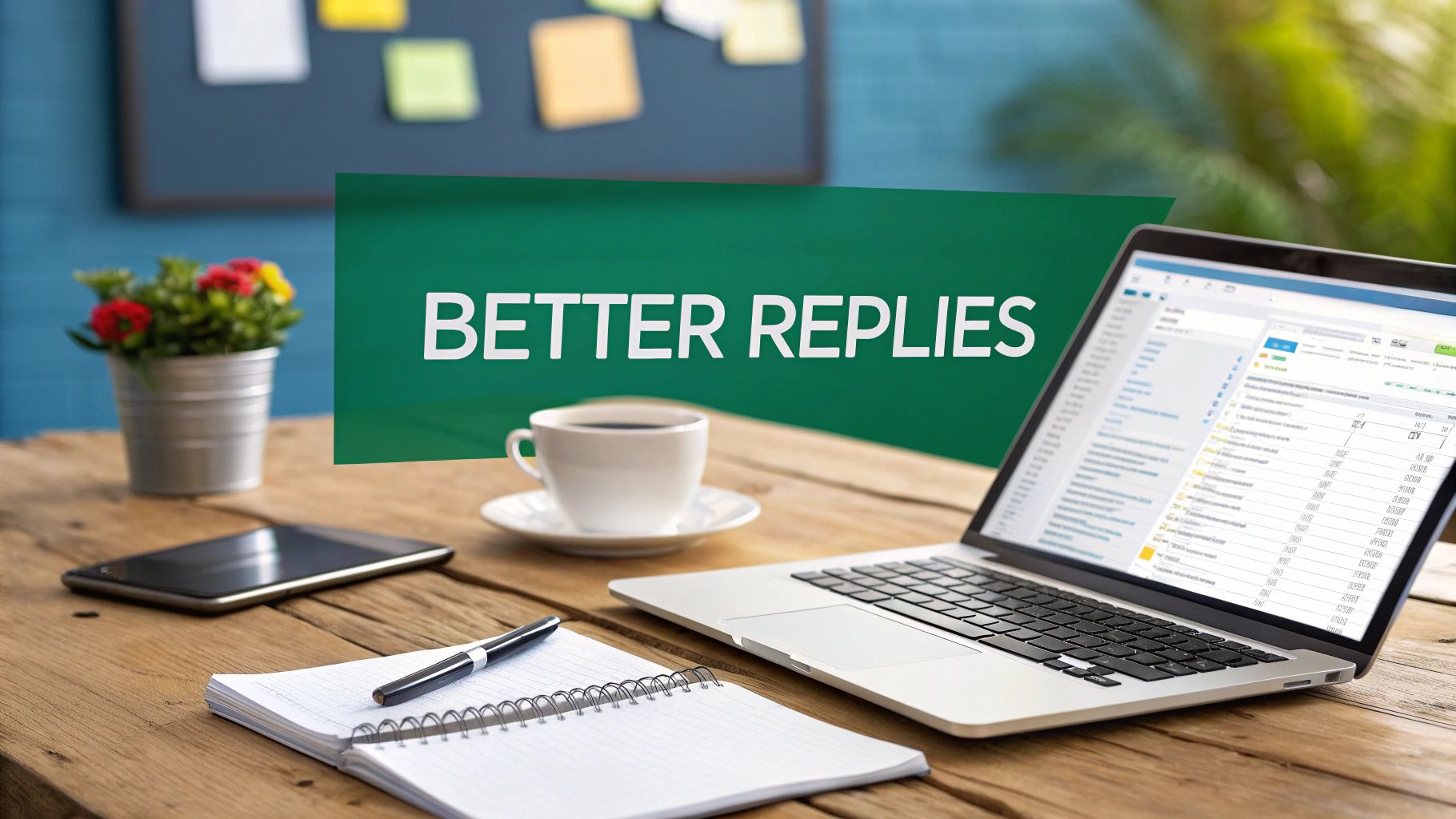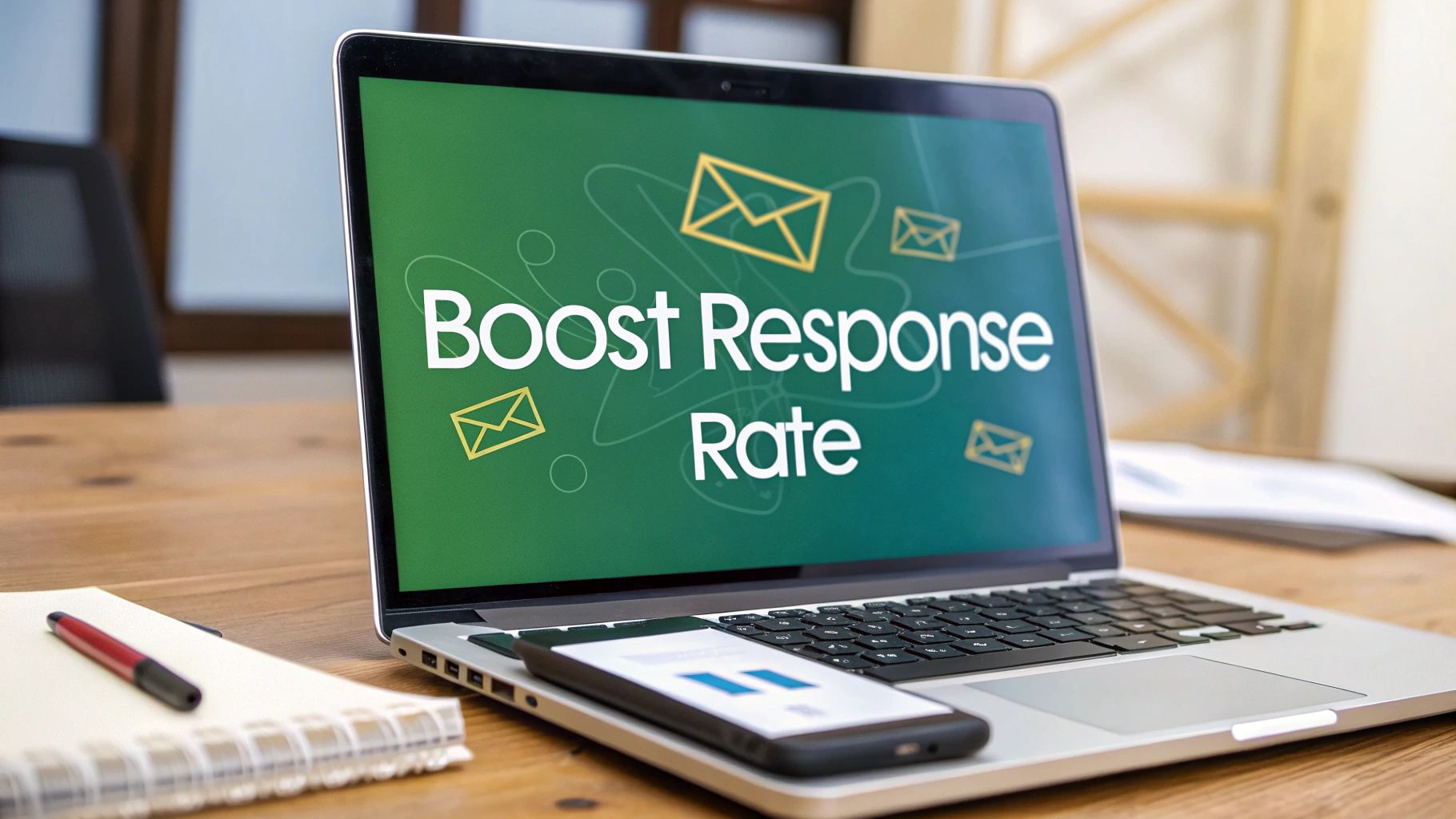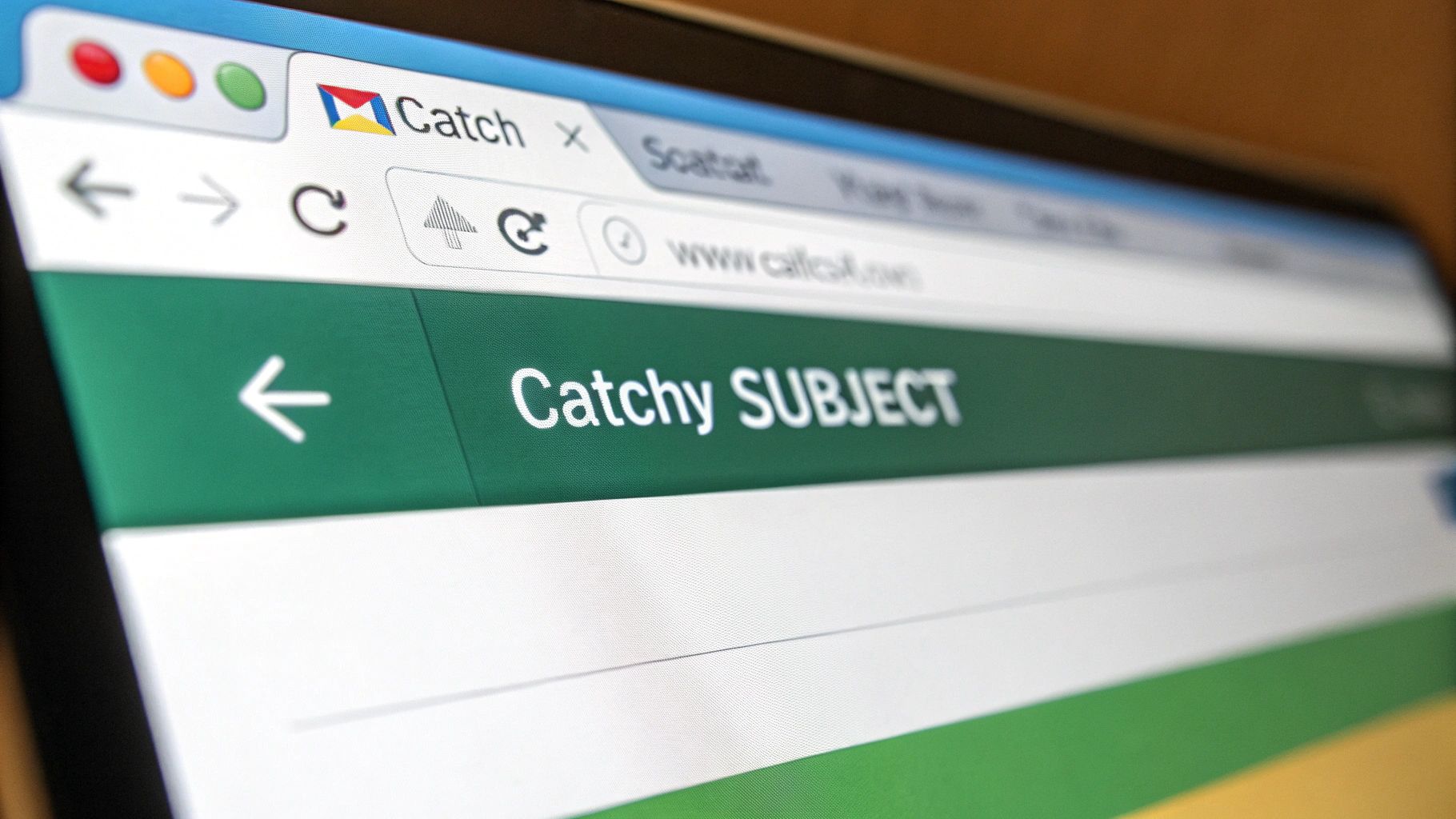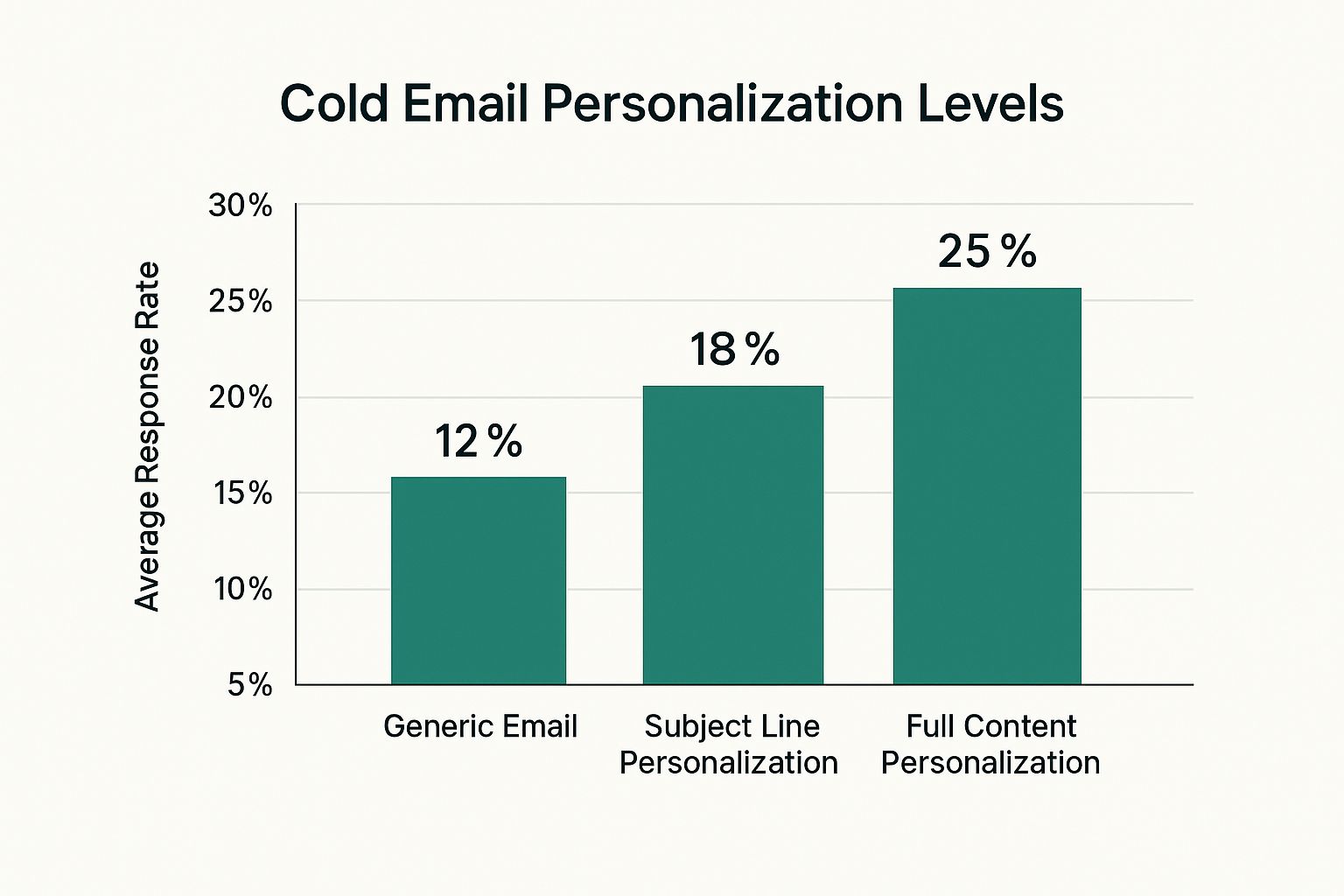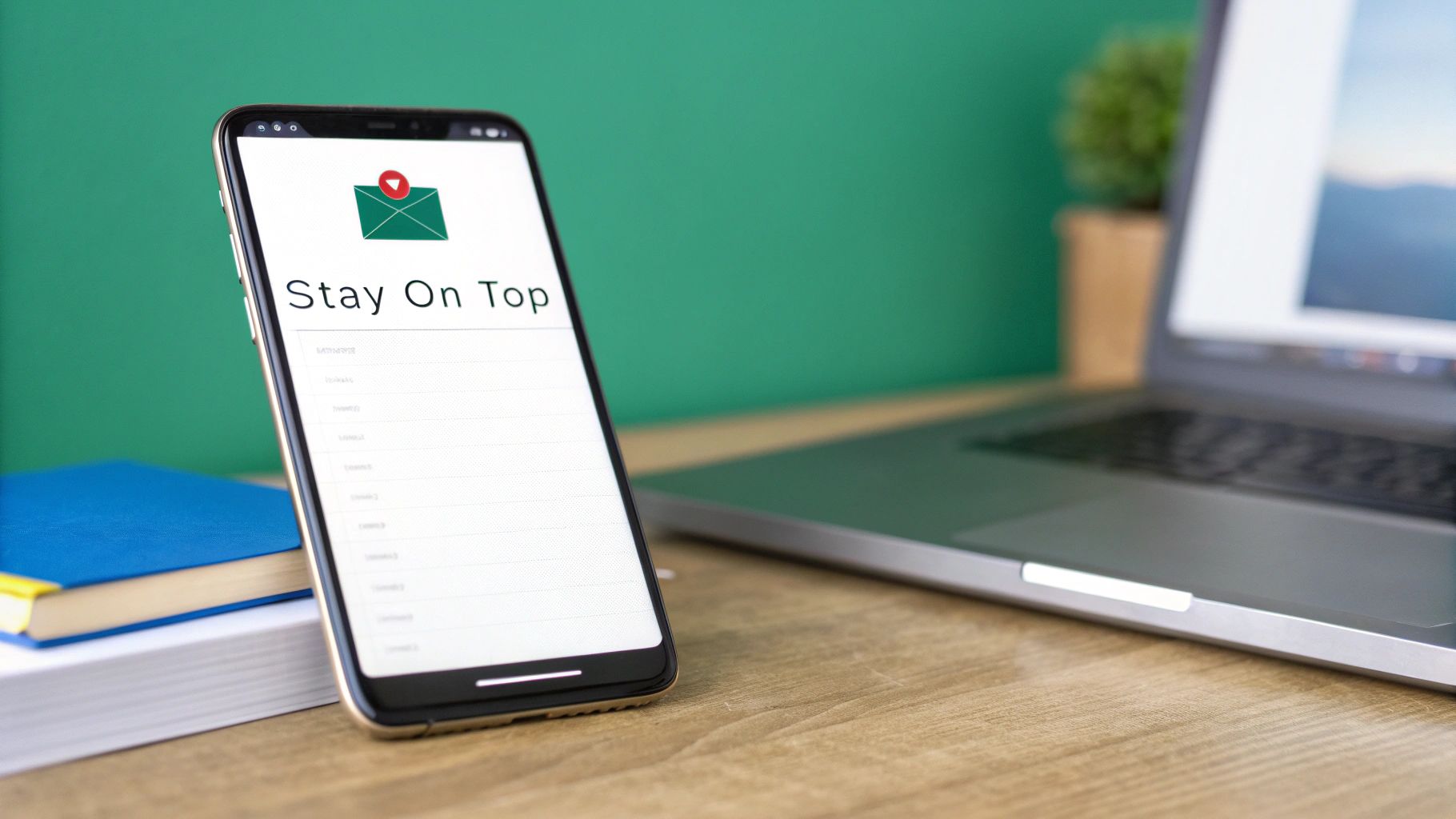Figuring out how to follow up when you get radio silence can feel like walking on eggshells. The trick is to send a short, polite message that adds a little extra value, gives a gentle nudge about your first email, and ends with a crystal-clear, easy-to-do call-to-action.
This simple shift turns a needy "just checking in" email into a smart, strategic conversation starter.
Why Your First Email Went Unanswered

It’s easy to jump to conclusions and think, "They're just too busy." But honestly, the silence is often a sign that something in your original email missed the mark.
Before you can fix it, you have to figure out why it didn't connect. Was your offer confusing? Was your ask too big? Nailing down these potential problems is the first real step to writing a follow-up that actually gets a reply.
Plenty of outreach campaigns fizzle out because they just don't stand out in a sea of other emails. The data is pretty clear: mastering the follow-up is what separates the pros from the amateurs. Response rates for cold emails can be as low as 1% to 8.5%. But campaigns that use smart, targeted follow-ups? They can see incredible response rates of 40% to 50%.
Quick Diagnosis for Unanswered Emails
Sometimes, the problem isn't a lack of interest—it's that your email didn't make a strong enough case for their time and attention. Before you hit send on another message, a quick diagnosis can help you pinpoint what went wrong.
This table breaks down some of the most common reasons for a no-reply and gives you a clear strategy for your next attempt.
| Potential Problem | Strategic Fix for Your Follow-Up |
|---|---|
| Weak or Vague Value Prop | Re-explain the benefit from a new angle or highlight a different specific outcome. |
| Unclear or High-Effort CTA | Simplify your ask. Instead of a 30-min call, ask a simple yes/no question. |
| Bad Timing or Irrelevance | Offer a relevant resource (like a case study or blog post) to show you understand their world. |
| Confusing or Long Message | Get straight to the point. Trim your message down to the absolute essentials. |
By thinking through these points, you can turn your follow-up into a much more compelling message that’s easier for them to say "yes" to.
Instead of just bumping your first email back to the top of their inbox, your real goal is to give them a new reason to engage. For a closer look at what makes an initial email work, you can check out some data on average cold email response rates.
Key Takeaway: The silence on the other end isn't personal—it's feedback. Use it to refine your approach, add more value, and make responding feel effortless for the recipient.
Think of your follow-up as a chance to re-pitch your idea from a slightly different angle. Maybe you can share a helpful resource, shine a light on a different benefit, or just make your request a whole lot simpler. This kind of thoughtful persistence shows you’re a professional who genuinely believes in the value you’re bringing to the table.
Writing a Follow-Up That Actually Gets Read
So, your carefully crafted email vanished into the void. No reply. The natural impulse is to fire off a quick "just checking in" message, but that's a huge missed opportunity.
Think of your follow-up as more than just a nudge; it's your second chance to make a real impression and prove your email is worth their time.
A great follow-up really only does three things: it jogs their memory about the original email, offers something new and valuable, and makes hitting "reply" almost effortless. Get that balance right, and you’ll start turning silence into actual conversations.
Crafting a Subject Line That Re-Engages
First things first: the subject line. Your goal here is to be familiar without being boring. Just hitting "forward" and typing "Following up" is lazy, and honestly, it can come across as a little passive-aggressive. You need to aim for clarity and context.
- For Sales Outreach: Try something like, "Re: [Original Subject] – Quick Question" or "A thought on [Their Company Goal]." This links back to your first email but hints that you have something new to add.
- For Job Applications: Be direct. "Following up on my application for the [Job Title] role" is perfect. It’s professional and makes it dead simple for a busy recruiter to find your file.
- For Networking: A friendly touch works best. "Enjoyed our chat at [Event Name]" is personal and instantly reminds them who you are.
The best subject lines are short, specific, and create just enough curiosity to get that open. Keeping it between 30-50 characters is a good rule of thumb, especially since most people will see it on their phone first.
Adding New Value Is Non-Negotiable
This is the part where most follow-ups completely fall flat. Just repeating your original request gives them zero new reasons to respond. People are busy. Their priorities have changed since yesterday. The single best way to master how to follow up on an email with no response is to bring something new to the table.
So, what does "new value" actually look like?
- Share a Relevant Resource: Did you stumble upon an article, a case study, or a tool that solves a problem they mentioned? Send it over. A simple "Came across this and thought of our conversation about scaling your team" works wonders.
- Offer a New Insight: Maybe you had a fresh idea after you sent the first email. A quick note like, "I was thinking more about your challenge with [X], and it occurred to me that [Y] could be a solution" shows you’re genuinely thinking about their problems.
- Provide a Quick Win: Instead of immediately asking for a 30-minute call, offer a small piece of advice they can use right away. For example, "I noticed a small tweak you could make on your website that might boost conversions."
This simple shift changes the entire dynamic. You’re no longer someone asking for something; you're someone offering something. It’s a subtle change, but it shows you respect their time and have real expertise to share. Your first email sets the stage, but the follow-up is where you prove you’re a connection worth having. If you're still dialing in that first message, our guide on how to write cold emails can help.
Design a Low-Friction Call-to-Action
Okay, you’ve reminded them of the context and offered new value. The last step is to make it incredibly easy for them to reply. Vague CTAs like "Let me know your thoughts" feel like work. You need to be specific and make the ask as small as humanly possible.
Just look at the difference between these two:
High-Friction CTA: "Are you free for a 30-minute call next week to discuss this further?"
Low-Friction CTA: "Would learning more about this be a priority for you right now?"
The second one is a simple yes/no question. It takes almost no mental energy to answer. If they say "yes," then you can figure out the scheduling. This micro-commitment approach is way more effective at getting that initial reply, which is the only goal that matters for a follow-up email.
Mastering Your Follow-Up Timing and Cadence
Sending a brilliant follow-up at the wrong moment is like telling a great joke to an empty room—it just doesn't land. The art of the follow-up isn't just about what you say; it's about when you say it. Getting this rhythm right is the key to staying persistent without becoming a pest.
The timing of your messages can dramatically change your outcomes. In fact, data shows the first follow-up email can get a reply rate that's 40% higher than later attempts. Speed is also a massive factor in some situations; companies that respond to new leads within just five minutes are 100 times more likely to actually connect and convert them. Delaying even a day can have a huge impact. You can read more about these powerful follow-up statistics to see just how much timing matters.
This infographic gives you a great visual guide on structuring a follow-up to grab your recipient's attention.

As the image highlights, a successful email has to immediately capture attention, which reinforces why a well-timed and well-crafted message is so important.
Finding the Right Cadence
Look, there's no single magic number for how long you should wait, but there are some smart guidelines that work for most situations. Your goal is to build a cadence that respects their inbox while keeping your request top-of-mind.
A solid starting point is what I call the "3-5-7 rule," which you can easily adapt based on your specific needs. It’s a balanced approach that gives you a clear follow-up sequence.
- First Follow-Up: Wait 2-3 business days after your initial email. This is the sweet spot—enough time for them to have seen your message, but not so long that they've completely forgotten it.
- Second Follow-Up: Give it another 4-5 business days. At this point, you're giving them more space and acknowledging they're likely busy.
- Third Follow-Up (and beyond): Extend the gap to 7+ business days. Each message from here on out should be more spaced out to avoid overwhelming their inbox.
Your cadence isn't set in stone. If your request is time-sensitive, like following up after a job interview where they mentioned a decision timeline, you can absolutely shorten these windows. For less urgent networking, feel free to stretch them out.
When to Adjust Your Timing
Context is everything when you're deciding how to follow up on an email with no response. The perfect timing can shift based on who you're talking to and why.
For instance, reaching out to a C-suite executive requires more patience than connecting with a junior team member. Their schedules are slammed, so longer intervals between emails feel more respectful and are often more effective.
Think about these common scenarios:
- After a Sales Demo: Following up within 24 hours is pretty standard. You want to capitalize on their interest while the details are still fresh in their mind.
- Post-Networking Event: A quick "great to meet you" email or a connection request within 1-2 days is perfect. It solidifies the connection before the memory of your chat fades.
- Following Up on a Proposal: Give them a few business days (3-5 days) to review the document with their team before you check in. Rushing them can come across as pushy and might undermine your position.
Ultimately, the best cadence is one that feels natural for the relationship and the context. Listen to the signals. If you've sent three or four well-spaced, value-driven emails with zero response, it’s a strong sign to pause your outreach and try a different approach down the road.
Follow-Up Email Examples for Any Scenario
Knowing the theory behind a good follow-up is one thing, but having battle-tested examples you can adapt makes all the difference. This is your practical toolkit for turning silence into a conversation.
Whether you’re nudging a cold lead, checking in after an interview, or waiting on a proposal, the right words matter. The goal isn't just to remind them you exist; it's to re-engage them with a message that feels helpful, respectful, and easy to act on.
The Gentle Nudge for Cold Outreach
When an initial cold email goes unanswered, your first follow-up is often your best shot at getting a reply. Don't just "bump" the old message. Instead, come at it from a slightly different angle and reframe your value.
Example: The Quick Value-Add Follow-Up
Subject: Re: [Original Subject] – a quick thought
Hi [First Name],
Just wanted to circle back on the email I sent last week about [original topic].
I was thinking about your goal of [mention their company goal] and came across this case study on how [Similar Company] tackled the same challenge. Thought you might find it interesting: [Link]
Is solving [pain point] a priority for your team right now?
Best,
[Your Name]
Why It Works: This approach instantly provides fresh value—the case study—and connects it directly to a goal they likely care about. The final question is a simple yes/no, making it far easier to answer than a request for a call. For more ideas on nailing that first message, check out these examples of cold emails from our guide.
Following Up After a Job Interview
The post-interview follow-up is all about showing continued enthusiasm without being pushy. It’s a delicate balance, but a polite check-in can absolutely keep you top of mind.
Example: The Professional Check-In
Subject: Following up on the [Job Title] role
Hi [Hiring Manager Name],
Hope you’re having a great week.
I really enjoyed our conversation on [day of interview] about the [Job Title] position and learning more about the team at [Company Name].
You mentioned a decision might be made around this time, so I just wanted to politely check in on the status of the role. I'm still very interested and confident that my skills in [mention 1-2 key skills] would be a great asset.
Please let me know if there's anything else you need from my end.
All the best,
[Your Name]
Why It Works: It’s respectful and references the timeline they provided, which shows you were listening. It also briefly restates your interest and key qualifications without just repeating your resume. You're simply staying engaged in the process.
Checking on a Submitted Proposal or Quote
Once you've sent a proposal, the client is probably reviewing it and discussing it with their team. Your follow-up should be designed to help that conversation along, not pressure them into a decision.
Example: The Helpful Resource Follow-Up
Subject: Re: Proposal for [Project Name]
Hi [Client Name],
Just wanted to follow up on the proposal I sent over last [Day].
I know you’re likely discussing it with your team. To help with that conversation, I’ve attached a brief document outlining the ROI our other clients in the [Their Industry] space have seen.
Do you have any initial questions I can help answer?
Regards,
[Your Name]
Why It Works: This email anticipates their internal process and provides a resource to help them make their case. It positions you as a helpful partner, not just another vendor waiting for a signature. It shows them you're thinking one step ahead.
Follow-Up Template Selector
Choosing the right approach depends entirely on your goal and your existing relationship with the person you're emailing. Use this quick guide to match your situation to the most effective follow-up style.
| Scenario | Key Objective | Recommended Tone | Core Value Proposition |
|---|---|---|---|
| Cold Outreach | Get a first reply | Helpful & Concise | A new piece of relevant information (case study, article). |
| Post-Interview | Stay top-of-mind | Professional & Enthusiastic | A reminder of your key skills and continued interest. |
| Proposal Sent | Facilitate a decision | Supportive & Proactive | A resource to help them make an internal business case. |
| Networking Event | Re-establish connection | Friendly & Specific | A reminder of your conversation and a clear next step. |
| Old Client Re-engagement | Restart a conversation | Familiar & Value-Driven | A relevant update or a new idea tailored to them. |
Each scenario demands a slightly different touch. The key is to always lead with value and make it incredibly easy for the other person to respond.
Advanced Follow-Up Strategies Beyond Email

When your best emails are met with silence, the gut reaction is to just send another one. But honestly, sometimes the best move is to get out of the inbox altogether. A smart multi-channel approach can get you noticed without making you look desperate.
This requires a bit of finesse, though. The goal is to be present, not a pest. If you've already sent a couple of emails and heard nothing back, a light touch on a different platform can be the nudge that gets you a reply.
Using Social Platforms Strategically
LinkedIn is your best friend here. But please, don't just slide into their DMs with a "Hey, did you see my email?" That's the fastest way to get ignored or blocked. You have to be more subtle.
- Engage with their content. A thoughtful comment or even a simple 'like' on a recent post puts your name on their radar in a low-pressure, professional way.
- Send a connection request. Keep the note short and to the point. Something like, "Hi [Name], I sent a note over to your team last week about [topic]. Thought it'd be great to connect here, too."
This simple move completely changes the game. You're no longer just another unread email; you're a real person and a professional contact in their network. That small shift is often all it takes.
Knowing When to Send the Breakup Email
Look, persistence pays off. But there's a fine line between being persistent and being annoying. The data doesn't lie: around 80% of sales require five or more follow-ups, but most people give up way too soon. While those first couple of follow-ups give you a nice bump in reply rates, the real magic often happens later in the sequence. You can dig into some more of these insightful sales follow-up statistics if you're curious.
So, what do you do after you've sent a series of emails—say, 4 or 5—and still have nothing? It's time for the "breakup email." This isn't about being dramatic. It's about professionally closing the loop while leaving the door open for the future.
The Breakup Email Example
Subject: Closing the loopHi [Name],
I've reached out a few times about [your offer] but haven't heard back. I'll assume it's not a priority for you right now, so this will be my last email.
If you ever decide to explore [solving their problem] in the future, please feel free to get in touch.
All the best,
[Your Name]
This message works wonders. It’s polite, it respects their time (and their silence), and it cleanly ends your follow-up sequence. You'd be surprised how often this email gets a response. Why? It takes all the pressure off and gives the other person an easy out. It’s a must-have tool for anyone trying to figure out how to follow up when an email gets no response.
Answering Those Awkward Follow-Up Questions
Even with the best templates in hand, you're bound to run into some tricky situations. Knowing how to play these moments can be the difference between getting that reply you've been waiting for and being left on read.
Let's walk through a couple of the most common dilemmas people face when they're figuring out how to follow up. This should help you handle these spots with a lot more confidence.
What If I Spot a Mistake in My First Email?
It happens to the best of us. You hit "send" and your stomach drops as you immediately spot a glaring typo or realize you attached the wrong file.
Don't panic. The best move is to send a quick, polite correction as soon as you notice the mistake.
Just address it directly and keep it short. A simple subject line like "Correction: [Original Subject]" is all you need.
Here's how that might look:
"Hi [Name], just a quick correction on my last email—I noticed a typo in the project timeline I sent over. My apologies for any confusion. The correct date for the project kickoff is actually [Correct Date]."
This approach shows you're on top of things and have a good eye for detail. It fixes the error without a lot of drama and, as a bonus, bumps your message right back to the top of their inbox.
How Should I Change My Tone for Different Seniority Levels?
Your tone absolutely has to shift depending on who you're emailing. When you're following up with a C-suite executive or a senior manager, you always want to lean toward being more formal and concise.
- For Executives: Get straight to the point. They're incredibly busy, so they value brevity more than anything else.
- For Peers or Junior Staff: A slightly more casual and friendly tone is usually fine. In fact, it can help you build a better working relationship.
At the end of the day, it's all about showing respect for their time. For a high-level contact, that means a short, direct message. For a colleague, it might mean a more conversational and collaborative style.
Ready to stop guessing and start connecting? EmailScout helps you find the right email addresses for key decision-makers in a single click, ensuring your perfectly crafted follow-up messages land in the right inbox every time. Find unlimited emails for free.
